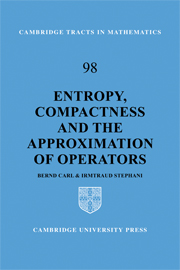2 - Approximation quantities
Published online by Cambridge University Press: 05 February 2012
Summary
Entropy and compactness properties of operators are closely related to approximation properties. ‘Approximation’ means approximation by finite rank operators. Approximation quantities are non-increasing sequences of non-negative numbers sn(T) defined for arbitrary operators T between Banach spaces and, in some sense, express the degree of approximability of T by finite rank operators. We shall deal with the so-called approximation numbers and with Kolmogorov and Gelfand numbers. In their original meaning both Kolmogorov and Gelfand numbers – like entropy numbers – are set functions. They entered the mathematical literature as certain diameters of sets. The definitive paper by Kolmogorov appeared in 1936 (cf. Kolmogorov 1936). For the diameters in the sense of Gelfand, we do not feel able to date their origin. However, for a detailed and comprehensive survey of the development of the theory of diameters we recommend the book by Pinkus (1985). In the present book, for the sake of economy, we shall confine ourselves to Kolmogorov and Gelfand numbers of operators as they were considered within a general theory of so-called s-numbers of operators by Pietsch (see Pietsch 1974, 1978). Nevertheless, we refer to the geometrical meaning of Kolmogorov numbers and Gelfand numbers. The particular definition of Gelfand numbers that we give (see (2.3.5)) has not been used in literature so far (see Stephani 1987). It is thought to emphasize the analogy to the geometrical definition of the Kolmogorov numbers (see (2.2.4)) irrespective of duality arguments.
- Type
- Chapter
- Information
- Entropy, Compactness and the Approximation of Operators , pp. 41 - 94Publisher: Cambridge University PressPrint publication year: 1990

